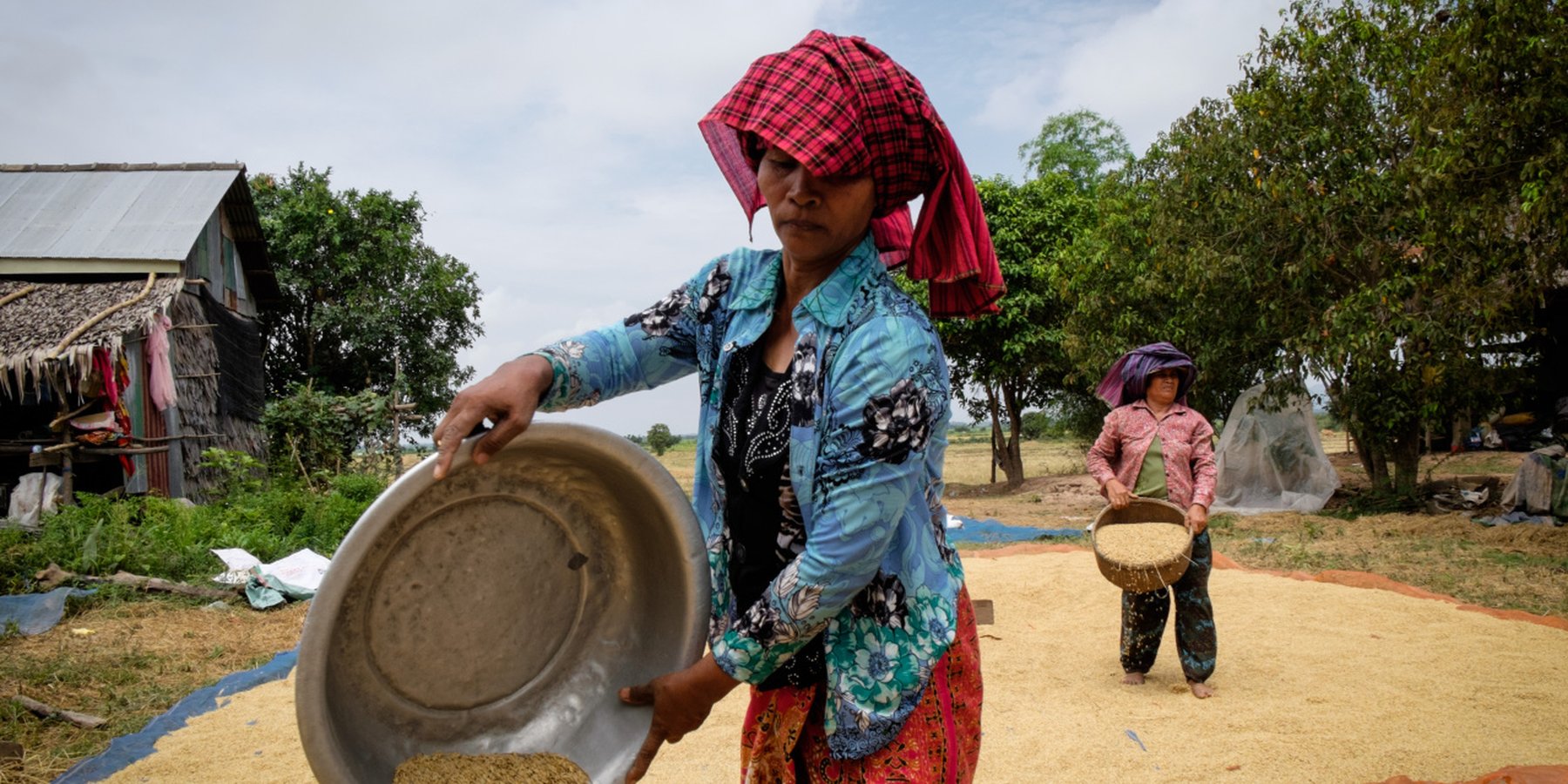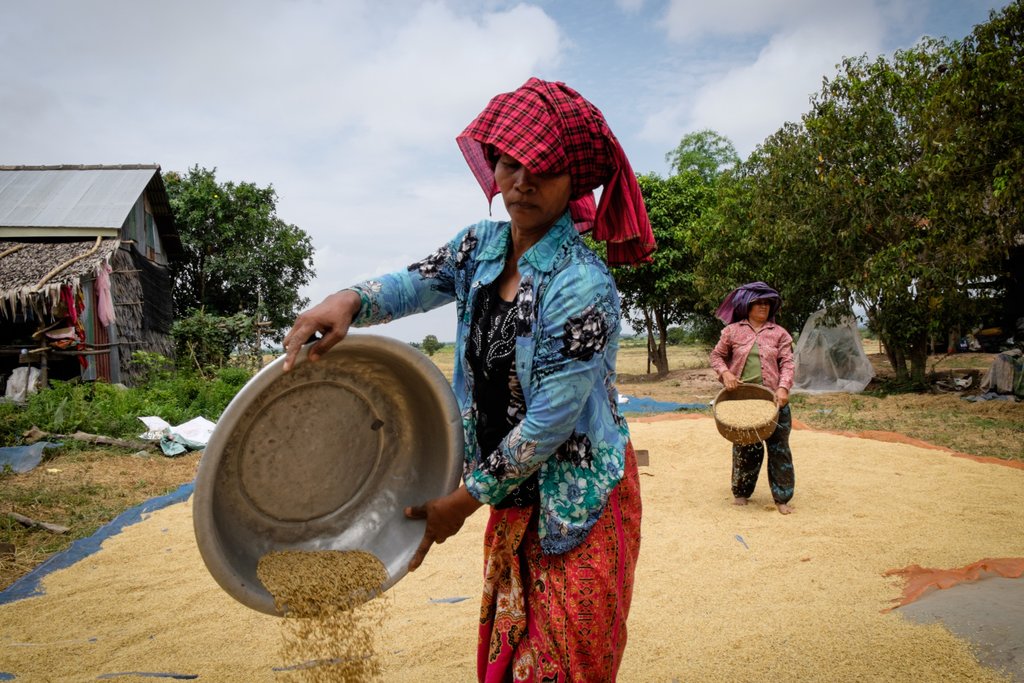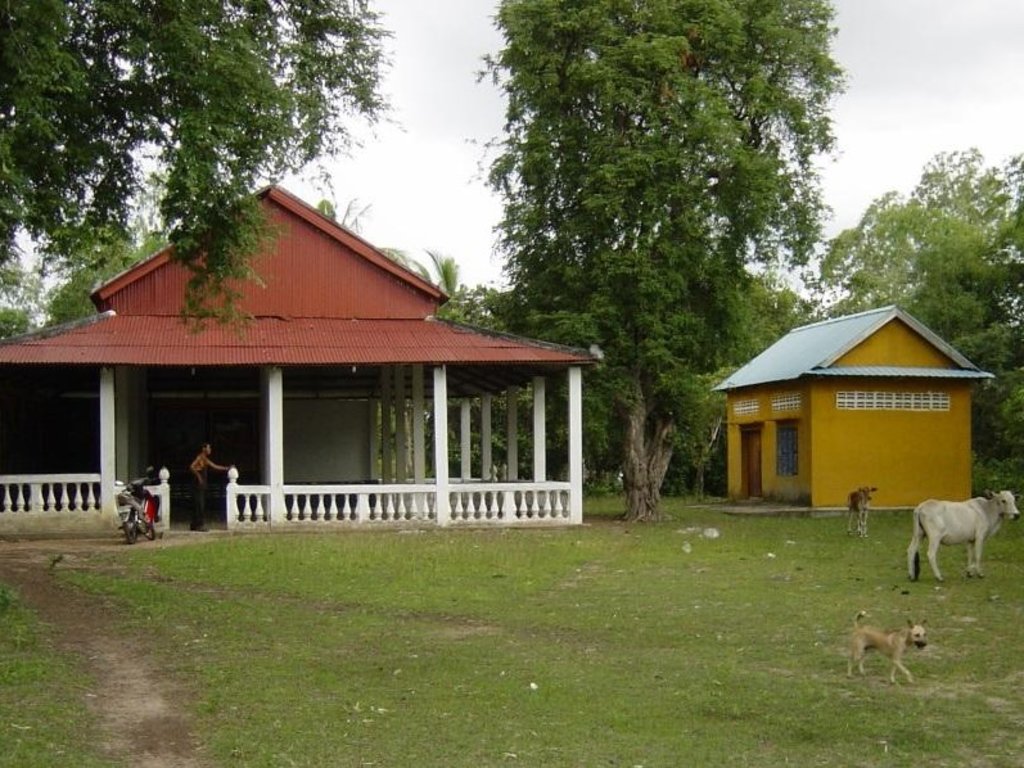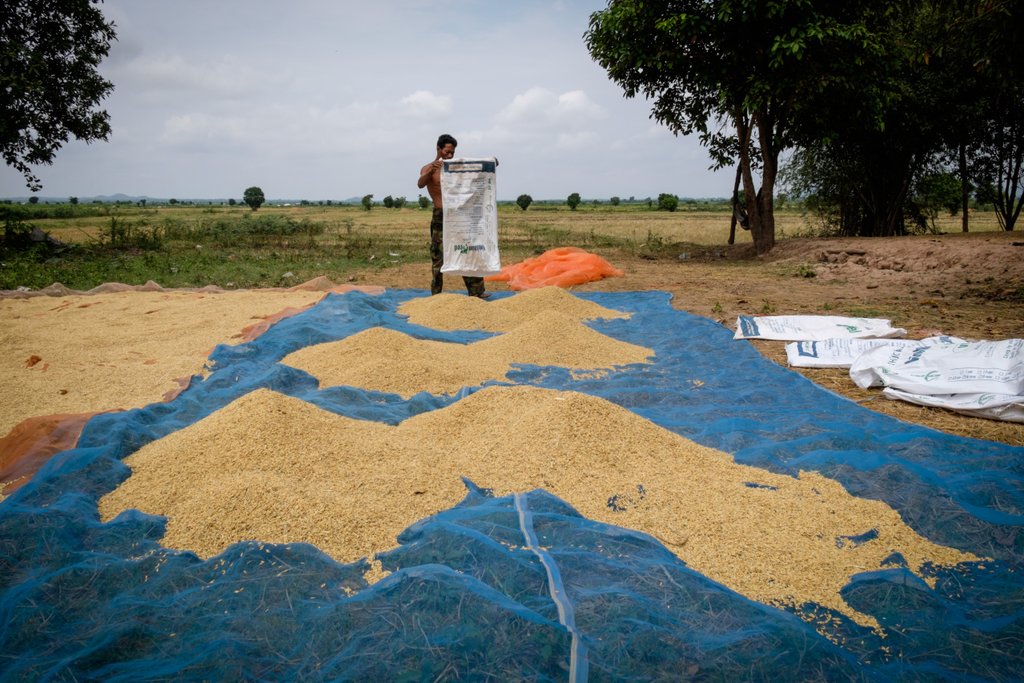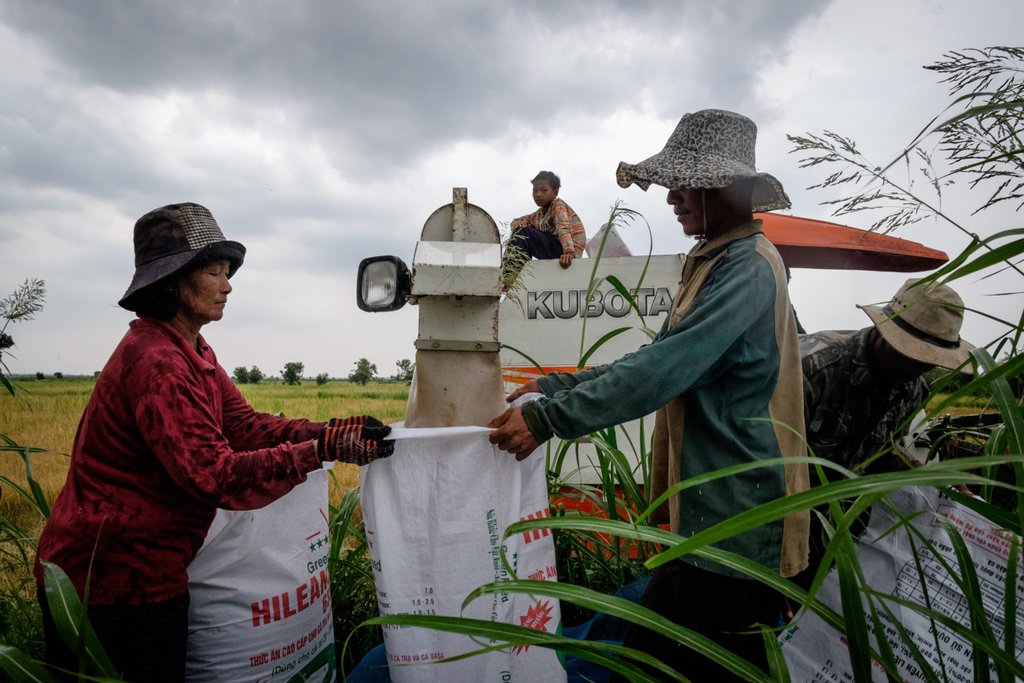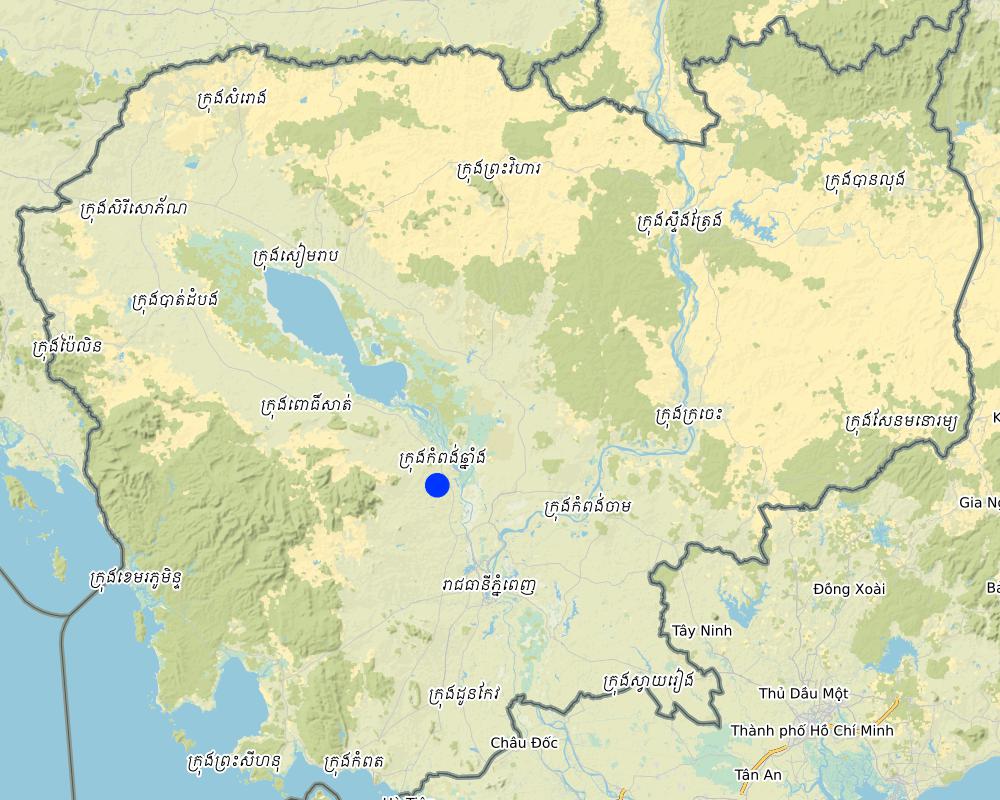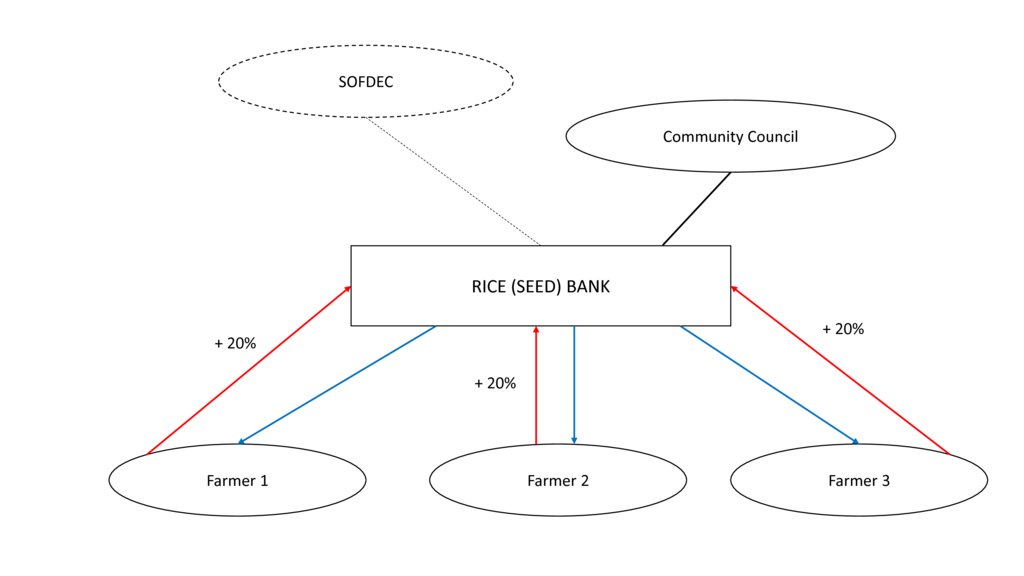Community Safety Nets - Establishment of rice seed banks at village level [กัมพูชา]
- ผู้สร้างสรรค์:
- การอัพเดท:
- ผู้รวบรวม: Stefan Graf
- ผู้เรียบเรียง: Stefan Graf, Christoph Kaufmann, Christine Lottje, Judith Macchi
- ผู้ตรวจสอบ: Boris Orlowsky, Alexandra Gavilano, Judith Macchi
approaches_1848 - กัมพูชา
ดูส่วนย่อย
ขยายทั้งหมด ย่อทั้งหมด1. ข้อมูลทั่วไป
1.2 รายละเอียดที่ติดต่อได้ของผู้รวบรวมและองค์กรที่เกี่ยวข้องในการประเมินและการจัดเตรียมทำเอกสารของแนวทาง
วิทยากรหลัก
ผู้เชี่ยวชาญ SLM:
Khun Lean Hak
kleanghak@yahoo.com / sofdec@camintel.com
SOFDEC/LAREC
กัมพูชา
ผู้เชี่ยวชาญ SLM:
Bin Sreytouch
Society for Community Development in Cambodia SOFDEC
กัมพูชา
Say Mesa
Society for Community Development in Cambodia SOFDEC
กัมพูชา
ผู้เชี่ยวชาญ SLM:
Pit Khonhel
Local Agriculture Research and Extension Centre LAREC
กัมพูชา
ชื่อของโครงการซึ่งอำนวยความสะดวกในการทำเอกสารหรือการประเมินแนวทาง (ถ้าเกี่ยวข้อง)
Book project: where people and their land are safer - A Compendium of Good Practices in Disaster Risk Reduction (DRR) (where people and their land are safer)1.3 เงื่อนไขที่เกี่ยวข้องกับการใช้ข้อมูลที่ได้บันทึกไว้ผ่านทาง WOCAT
วันที่เก็บรวบรวมข้อมูล (ภาคสนาม):
16/04/2014
ผู้รวบรวมและวิทยากรหลักยอมรับเงื่อนไขเกี่ยวกับการใช้ข้อมูลที่ถูกบันทึกผ่านทาง WOCAT:
ใช่
2. คำอธิบายของแนวทาง SLM
2.1 การอธิบายแบบสั้น ๆ ของแนวทาง
A rice (seed) bank is a community safety net system where farmers can get both rice seeds for cultivation and rice for consumption from a communal storage house in order to increase their food security by guaranteeing: (1) year-round access to high quality seeds and rice for consumption, (2) access to seed and rice for consumption after an extreme weather event (drought, flood) and (3) improved quality of the planted seeds through the provision of new varieties better adapted to local conditions (e.g. fast maturing, floating rice)
2.2 การอธิบายอย่างละเอียดของแนวทาง
การอธิบายอย่างละเอียดของแนวทาง:
A rice (seed) bank is a system where farmers can get both high quality rice seeds for planting and rice for consumption from a communal storage house. Requirement for the use of the rice (seed) bank is that farmers pay back the purchased rice seeds or rice for food with a 20% interest rate after their next harvest. The bank is managed by a community council consisting of members of the village in collaboration with the local NGO Society for Community Development in Cambodia - SOFDEC.
The rice (seed) banks act as a community safety net in the villages to guarantee food security despite the threat of extreme weather events such as drought or flood. Because of the constant access to high quality seeds, farmers can sow a second time in case the first sowing was lost due to a drought or flood. Also, the communal storage of rice for consumption helps particularly poor farmer families with small plots in case they do not get enough yield on their field to feed the household.
Moreover, new rice varieties, which are better adapted to local conditions and which also perform in the case of extreme weather (fast maturing, floating rice) are introduced through the rice (seed) bank. Besides these new varieties (the result of research carried out by the Local Agricultural Research and Extension Center LAREC in collaboration with other research institutes) have higher yields and can also be sold at a better price on the market.
The need for a rice (seed) bank is decided in participatory manner by the village community. In case a bank is established it is managed by a community council of elected community members. The council is responsible for the storage, the distribution and supervises the back payment of the rice (seed). Through the collaboration between the Community Council and SOFDEC, new SLM Technologies such as the System of Rice Intensification can be promoted in the target villages.
The stages of implementation are as follows:
1. SOFDEC consults with the villagers about the aim and the need for a rice (seed) bank. Generally, rice banks are established if farmers express that there is a high exposure to extreme weather event, low food security and/or rice seeds are of bad quality (bad germination, low yields).
2. The decision about the establishment and implementation of a rice (seed) bank is made by the village community.
3. A Community Council is elected by the villagers and trained on their role and functioning of the rice (seed) bank by SOFDEC staff.
4. The communal storage is built. Building materials are provided by SOFDEC, the community contributes with labor.
5. SOFDEC provides a first stock of high quality rice seeds from LAREC and rice for consumption.
6. After the first harvest, the farmers pay back the seeds and rice consumed with a 20% interest rate.
7. SOFDEC monitors the functioning of the rice seed banks and takes a mediating role in case that problems between the community council and the village community arises.
2.3 รูปภาพของแนวทาง
2.5 ประเทศ ภูมิภาค หรือสถานที่ตั้งที่ได้นำแนวทางไปใช้
ประเทศ:
กัมพูชา
ภูมิภาค/รัฐ/จังหวัด: :
Kampong Chhnang
ข้อมูลเฉพาะเพิ่มเติมของสถานที่ตั้ง:
Different districts
ความคิดเห็น:
There are 11 rice banks in the area, benefitting 11 villages. The Society for Community Development in Cambodia (SOFDEC) has been implementing rice banks in different villages of Kampong Chhnang Province since 2000.
Map
×2.6 วันที่เริ่มต้นและสิ้นสุดของแนวทาง
ระบุปีที่เริ่ม:
2000
2.7 ประเภทของแนวทาง
- ใช้โครงงานหรือแผนงานเป็นฐาน
2.8 เป้าหมายหรือวัตถุประสงค์หลักของแนวทาง
The main aim of the approach is to increase the resilience of farmer families by improving their food security (rice seeds and rice for food are now available the whole year round, mutual support after droughts or floods possible), increasing their income (rice varieties higher yielding) as well as strengthening local institutions (community committees manage the rice banks, and participate in decision making on a local level).
2.9 เงื่อนไขที่เอื้ออำนวยหรือเป็นอุปสรรคต่อการนำเทคโนโลยีภายใต้แนวทางนี้ไปปฏิบัติใช้
บรรทัดฐานและค่านิยมทางสังคม วัฒนธรรม ศาสนา
- เอื้ออำนวย
Willingness of the community to support each other through a safety-net system
- เป็นอุปสรรค
Some farmers are reluctant to be part of the rice (seed) bank, as they do not want to use/consume someone else's rice, which might be of different quality than his/her own
การมีไว้ให้หรือการเข้าถึงแหล่งการเงินและบริการ
- เอื้ออำนวย
First inputs for the establishment of the rice (seed) banks are provided by the project (materials for the building of the bank, improved and locally adapted rice seed from LAREC)
- เป็นอุปสรรค
Some farmers struggle to repay the amount of rice borrowed including the requested interest rate of 20%, particularly after an extreme weather event (drought, flood)
การร่วมมือหรือการทำงานประสานกันของผู้ลงมือปฏิบัติ
- เอื้ออำนวย
Rice (seed) banks are decided upon and managed by the community itself through an elected community council
ความรู้เกี่ยวกับ SLM การเข้าถึงการสนับสนุนด้านเทคนิค
- เอื้ออำนวย
Through research done by the Local Agricultural Research and Extension Center LAREC, the rice varieties in the rice banks are adapted to the needs of the farmers (e.g. higher yielding, short breeding, drought resistant). Through the SOFDEC programme farmers are furthermore capacitated in new cultivation techniques (such as System of Rice Intensification - SRI).
- เป็นอุปสรรค
Lack of technical knowlegde on high quality seed multiplication leads to rice seed supply of bad quality in the rice bank.
3. การมีส่วนร่วมและบทบาทของผู้มีส่วนได้ส่วนเสียที่เกี่ยวข้อง
3.1 ผู้มีส่วนได้ส่วนเสียที่เกี่ยวข้องในแนวทางนี้และบทบาท
- ผู้ใช้ที่ดินระดับท้องถิ่นหรือชุมชนระดับท้องถิ่น
Farmers
Farmers can borrow rice seed and in case of a disaster also rice for consumption from the rice bank. After their next harvest the farmers have to pay back the rice (seed) borrowed with a 20% interest
- องค์กรที่ขึ้นอยู่กับชุมชน
Community council
Community Councils are elected by the community and are managing the rice banks and make sure that the regulation are met by the farmers participating in the rice banks
- องค์กรพัฒนาเอกชน
Society for Community Development in Cambodia - SOFDEC
SOFDEC is responsible for the planning and design of the approach, implementation of rice banks as well as for the financing of the initial establishment of the rice banks.
- รัฐบาลระดับท้องถิ่น
village chief
The village chief facilitates the introduction of the rice seed bank in the community and supports the community council in the steering of the banks as well as when facing problems within the village concerning the bank.
Furthermore, the village chief has to verify and acknowledge land acquisation documents land for rice bank construction and by-laws.
ถ้ามีผู้มีส่วนได้ส่วนเสียหลายคนที่เกี่ยวข้องให้ระบุหน่วยงานตัวแทน:
SOFDEC
3.2 การเกี่ยวข้องของผู้ใช้ที่ดินระดับท้องถิ่นหรือชุมชนระดับท้องถิ่นในช่วงต่างๆของแนวทาง
| ความเกี่ยวข้องของผู้ใช้ที่ดินระดับท้องถิ่นหรือชุมชนระดับท้องถิ่น | ระบุผู้ที่มีส่วนเกี่ยวข้องและอธิบายกิจกรรม | |
|---|---|---|
| การริเริ่มหรือการจูงใจ | ปฏิสัมพันธ์ | Land users are consulted regarding their needs for the establishment of a rice bank. |
| การวางแผน | ไม่ลงมือ | The planning and design of the rice banks is carried out by SOFDEC staff. |
| การดำเนินการ | จ่ายเงินหรือสนับสนุนจากภายนอก | Implementation of the banks is done by SOFDEC in consultation with the land users. SOFDEC finances the materials for the establishment of the rice banks, whereas the community contributes with their labor. Community agrees on the regulations (by-laws) for the implementation of the rice banks. |
| การติดตามตรวจสอบหรือการประเมินผล | ปฏิสัมพันธ์ | SOFDEC initially monitors the functioning of the rice banks (3-4 years after establishment). The community council is responsible for the everyday monitoring of the banks (e.g. participating farmers adhere to the regulations agreed on by the community). |
| research | ไม่ลงมือ | Research for improved locally adapted rice varieties (fast maturing, floating rice) is done by Local Agricultural Research and Extension Center- LAREC in collaboration with other research institutions. The improved seed developed by LAREC is stocked in the rice seed banks. |
3.3 แผนผังแสดงขั้นตอนการทำงาน (ถ้ามี)
คำอธิบาย:
Rice (seed) banks are established on a village level after consultation with the local farming community. The banks are managed by an elected community council. Farmers take out rice seed or rice for consumption (in case of an emergency) and pay back the amount of rice (seed) with an interest rate of 20%.
SOFDEC facilitates the establishment of the rice seed banks and provides the material for the building of the rice seed bank as well as the first supply of rice seed.
ผู้เขียน:
HEKS
3.4 การตัดสินใจเลือกใช้เทคโนโลยี SLM
ระบุผู้ที่ทำการตัดสินใจเลือกเทคโนโลยีมากกว่าหนึ่งวิธีไปปฏิบัติใช้:
- ผู้ใช้ที่ดินเป็นผู้ตัดสินใจหลัก โดยการสนับสนุนจากผู้เชี่ยวชาญ SLM
- n.a.
4. การสนับสนุนด้านเทคนิค การสร้างขีดความสามารถ และการจัดการด้านความรู้
4.1 การสร้างขีดความสามารถ / การอบรม
ได้มีการจัดอบรมให้แก่ผู้ใช้ที่ดินหรือผู้มีส่วนได้ส่วนเสียคนอื่น ๆ หรือไม่:
ใช่
ให้ระบุว่าใครเป็นผู้ได้รับการอบรม:
- ผู้ใช้ที่ดิน
ถ้าเกี่ยวข้อง ให้ระบุ เพศ อายุ สถานภาพ ชาติพันธุ์ เป็นต้น:
Community Councils and participating farmers
รูปแบบการอบรม:
- กำลังดำเนินการ
หัวข้อที่พูด:
Community councils were trained on functioning and administration of the rice bank. Farmers were trained on the multiplication and collection of rice seeds.
4.2 การบริการให้คำแนะนำ
ผู้ใช้ที่ดินมีการเข้าถึงการรับบริการให้คำปรึกษาหรือไม่:
ใช่
- n.a.
การอธิบาย/แสดงความคิดเห็น:
Knowledge exchange between the land users and SOFDEC staff.
Knowledge exchange between SOFDEC and the Provincial Department of Agriculture.
4.3 การเสริมความแข็งแกร่งให้กับสถาบัน (การพัฒนาองค์กร)
สถาบันได้รับการจัดตั้งขึ้นมาหรือเสริมความแข็งแกร่งโดยแนวทางนี้หรือไม่:
- ใช่ ปานกลาง
ระบุระดับของสถาบันที่ได้รับการเสริมความแข็งแกร่งหรือจัดตั้งขึ้นมา:
- ท้องถิ่น
อธิบายถึงสถาบัน บทบาทและความรับผิดชอบ สมาชิก เป็นต้น:
Community Councils
ระบุประเภทของการให้ความช่วยเหลือสนับสนุน:
- การสร้างขีดความสามารถ / การอบรม
4.4 การติดตามตรวจสอบและประเมินผล
การติดตามตรวจสอบและประเมินผลเป็นส่วนหนึ่งของแนวทางหรือไม่:
ใช่
ความคิดเห็น:
Everyday monitoring is ensured by the community council.
For the first 3-4 years after the establishment, SOFDEC monitors the implementation and functioning of the rice banks.
Monitoring aspects:
- No. of members, kg of rice taken out of the bank and payed back to the bank
- General attitude towards the rice bank (are the pay back mechanisms adhered to, etc.)
- Amount of yields and quality of rice (seeds), sometimes optimized
ถ้าตอบว่าใช่ แสดงว่าการจัดเตรียมเอกสารนี้มุ่งหวังที่จะเอาไปใช้สำหรับการติดตามตรวจสอบและประเมินผลใช่หรือไม่:
ใช่
4.5 การวิจัย
การวิจัยเป็นส่วนหนึ่งของแนวทางหรือไม่:
ไม่ใช่
5. การสนับสนุนด้านการเงินและวัสดุอุปกรณ์
5.1 ระบุงบประมาณประจำปีสำหรับแนวทาง SLM นี้
ถ้าหากว่างบประมาณประจำปีไม่เป็นที่ทราบแน่นอน ให้ระบุช่วงลงไป:
- 2,000-10,000
5.2 การสนับสนุนด้านการเงิน / วัสดุอุปกรณ์ให้แก่ผู้ใช้ที่ดิน
ผู้ใช้ที่ดินได้รับการสนับสนุนด้านการเงิน / วัสดุอุปกรณ์ไปปฏิบัติใช้เทคโนโลยีหรือไม่:
ใช่
ถ้าใช่ ให้ระบุประเภทของการสนับสนุน เงื่อนไขและผู้จัดหามาให้:
The project provides the materials for for rice bank construction.
5.3 เงินสนับสนุนสำหรับปัจจัยนำเข้า (รวมถึงแรงงาน)
- การเกษตร
| ระบุปัจจัยนำเข้าที่ได้รับการสนับสนุน | เห็นด้วยระดับไหน | ระบุเงินสนับสนุน |
|---|---|---|
| เมล็ด | ได้รับการช่วยเหลือทางการเงินแบบเต็ม | Rice seeds for the first season after the implementation of the rice bank is provided by the project. |
- วัสดุสำหรับการก่อสร้าง
| ระบุปัจจัยนำเข้าที่ได้รับการสนับสนุน | เห็นด้วยระดับไหน | ระบุเงินสนับสนุน |
|---|---|---|
| หิน | ได้รับการช่วยเหลือทางการเงินแบบเต็ม | All construction materials for the rice bank building is provided by the project. Type of construction (wood or stone) varied depending on the preferences of the village community. |
| ไม้ | ได้รับการช่วยเหลือทางการเงินแบบเต็ม | All construction materials for the rice bank building is provided by the project. Type of construction (wood or stone) varied depending on the preferences of the village community. |
ถ้าแรงงานโดยผู้ใช้ที่ดินเป็นปัจจัยนำเข้าที่มีอยู่มากมาย ระบุด้วยว่าเนื่องจาก:
- สมัครใจ
ความคิดเห็น:
Land users supported the establishment of the rice seed banks with their labor.
5.4 เครดิต
มีการจัดหาเครดิตมาให้ภายใต้แนวทาง SLM หรือไม่:
ไม่ใช่
5.5 แรงจูงใจหรือเครื่องมืออื่น ๆ
แรงจูงใจหรือเครื่องมืออื่น ๆ ได้ถูกนำไปใช้ส่งเสริมการใช้เทคโนโลยี SLM หรือไม่:
ไม่ใช่
6. การวิเคราะห์ผลกระทบและการสรุป
6.1 ผลกระทบของแนวทาง
ช่วยให้ผู้ใช้ที่ดินนำเอาเทคโนโลยี SLMไปใช้และบำรุงรักษาสภาพไว้ได้หรือไม่:
- ไม่ใช่
- ใช่ เล็กน้อย
- ใช่ ปานกลาง
- ใช่ อย่างมาก
Farmers have access to seed varieties which are adapted to local conditions (e.g. drought and flood resistance), ensuring that yields are also generated in case of an extreme weather event.
ทำให้กลุ่มด้อยโอกาสมีอำนาจทางสังคมและเศรษฐกิจหรือไม่:
- ไม่ใช่
- ใช่ เล็กน้อย
- ใช่ ปานกลาง
- ใช่ อย่างมาก
Rice (seed) banks are open to everybody. Thus, economically disadvantaged land users and ethnic minorities participate in rice banks. The rice banks function as safety nets in cases of extreme weather (e.g. droughts, floods) or economic despair.
นำไปสู่ความมั่นคงด้านอาหารหรือปรับปรุงโภชนาการให้ดีขึ้น:
- ไม่ใช่
- ใช่ เล็กน้อย
- ใช่ ปานกลาง
- ใช่ อย่างมาก
The rice banks offer year round access to high quality rice seed and rice for consumption all year round and also during extreme weather events. This allows farmers to sow out again in case one harvest gets lost. The rice bank also benefits farmers with small land plots – they might sell all their yields of new varieties on the market and buy with the return conventional rice for consumption, which is cheaper.
ปรับปรุงความสามารถของผู้ใช้ที่ดินในการปรับตัวให้เข้ากับการเปลี่ยนแปลงของสภาพภูมิอากาศหรือสภาพที่รุนแรงและภัยพิบัติหรือไม่:
- ไม่ใช่
- ใช่ เล็กน้อย
- ใช่ ปานกลาง
- ใช่ อย่างมาก
Increased resilience to extreme weather events because of the availability of both seeds and rice for consumption. Moreover, the seed varieties stored in the rice bank is adapted to local conditions (e.g. fast maturing, floating rice), ensuring that yields are also generated in case of an extreme weather event.
นำไปสู่โอกาสในการจ้างงาน รายได้หรือไม่:
- ไม่ใช่
- ใช่ เล็กน้อย
- ใช่ ปานกลาง
- ใช่ อย่างมาก
The new varieties promoted through the rice banks have higher yields, thus leading to more income for the farmers. Farmers also get higher prices on the market for the new rice varieties.
6.2 แรงจูงใจหลักของผู้ใช้ที่ดินเพื่อที่จะนำ SLM ไปปฏิบัติใช้
- การผลิตที่เพิ่มขึ้น
- ความเสี่ยงของภัยพิบัติลดลง
- well-being and livelihoods improvement
6.3 ความยั่งยืนของกิจกรรมของแนวทาง
ผู้ใช้ที่ดินสามารถทำให้สิ่งต่างๆ ที่ได้ปฏิบัติใช้โดยแนวทางนี้ยั่งยืนได้หรือไม่ (โดยไม่มีการสนับสนุนจากภายนอก):
- ใช่
ถ้าตอบว่าใช่ ให้อธิบายว่าอย่างไร :
Initial coaching by SOFDEC is needed, however, after 3 years the rice banks function without any external support.
6.4 จุดแข็งและข้อได้เปรียบของแนวทาง
| จุดแข็ง / ข้อได้เปรียบของแนวทางในทัศนคติของผู้ใช้ที่ดิน |
|---|
| The rice banks offer access to high quality seeds to all farmers in the community. |
|
Increased food security and resilience due to the permanent availability of rice seeds or rice for consumption. |
| More income due to higher yields and better prices for new varieties. |
| After about 3-4 years, the banks mostly work independently. |
6.5 จุดอ่อน / ข้อเสียเปรียบของแนวทางและวิธีในการแก้ไข
| จุดอ่อน / ข้อเสียเปรียบในทัศนคติของผู้ใช้ที่ดิน | สามารถแก้ไขปัญหาได้อย่างไร |
|---|---|
| Limited amount of rice (seed) to be borrowed. | Increase the storage capacity and conditions. |
| Required technical and managerial knowledge for the community councils is high. | Regular training sessions by SOFDEC |
| Rodents or insects might destroy the rice. | Apply narrow-mash nets to protect the rice from rodents and other animals |
| Some farmers do not comply with the required interest rates, delays in payback, etc. | Make a contract with them, decide on a step by step pay back manner, or if the farmer is not able repay (sick family member, loss of land, etc.) the whole group can decide to waive the debts |
| จุดอ่อน / ข้อเสียเปรียบในทัศนคติของผู้รวบรวมหรือวิทยากรหลัก | สามารถแก้ไขปัญหาได้อย่างไร |
|---|---|
| Seeds are treated with pesticides to make them last. | Improve the storage conditions or use different techniques to prevent pests (Integrated Pest Management IPM) |
| Only rice is considered. | Introduce a similar approach also for other plants in order to diversify the farmers’ income. Allow the farmer to pay back with other crops or varieties. |
7. การอ้างอิงและการเชื่อมต่อ
7.1 วิธีการหรือแหล่งข้อมูล
- ไปเยี่ยมชมภาคสนาม การสำรวจพื้นที่ภาคสนาม
- การสัมภาษณ์กับผู้ใช้ที่ดิน
- การเก็บรวบรวมมาจากรายงานและเอกสารที่มีอยู่
7.3 เชื่อมโยงกับข้อมูลที่มีอยู่บนออนไลน์
ชื่อเรื่องหรือคำอธิบาย:
The Society for Community Development in Cambodia (SOFDEC) is a Cambodian Non-Governmental Organization, established in 2006 through the localization of HEKS (the Swiss Church Aid) project in Kampong Chhnang province, Cambodia. The vision of SOFDEC is that Cambodian people living in Cambodia live a state of comfort, equality, equity, and have ownership over the sustainable development of their community. The mission of SOFDEC works in partnership with community based organizations and relevant institutions through integrated community development, research, human resource development, enhancement of family economies, in the hopes to uplift the living standards of the people in the target areas. Our goal aims to uplift the living standards of the rural people of Cambodia through the improvement in income generation, sustainable agricultural practices, microfinance, health, human resource development, and sustainable natural resource management.
URL:
www.sofdec.com
ลิงก์และโมดูล
ขยายทั้งหมด ย่อทั้งหมดลิงก์
ไม่มีลิงก์
โมดูล
ไม่มีโมดูล


